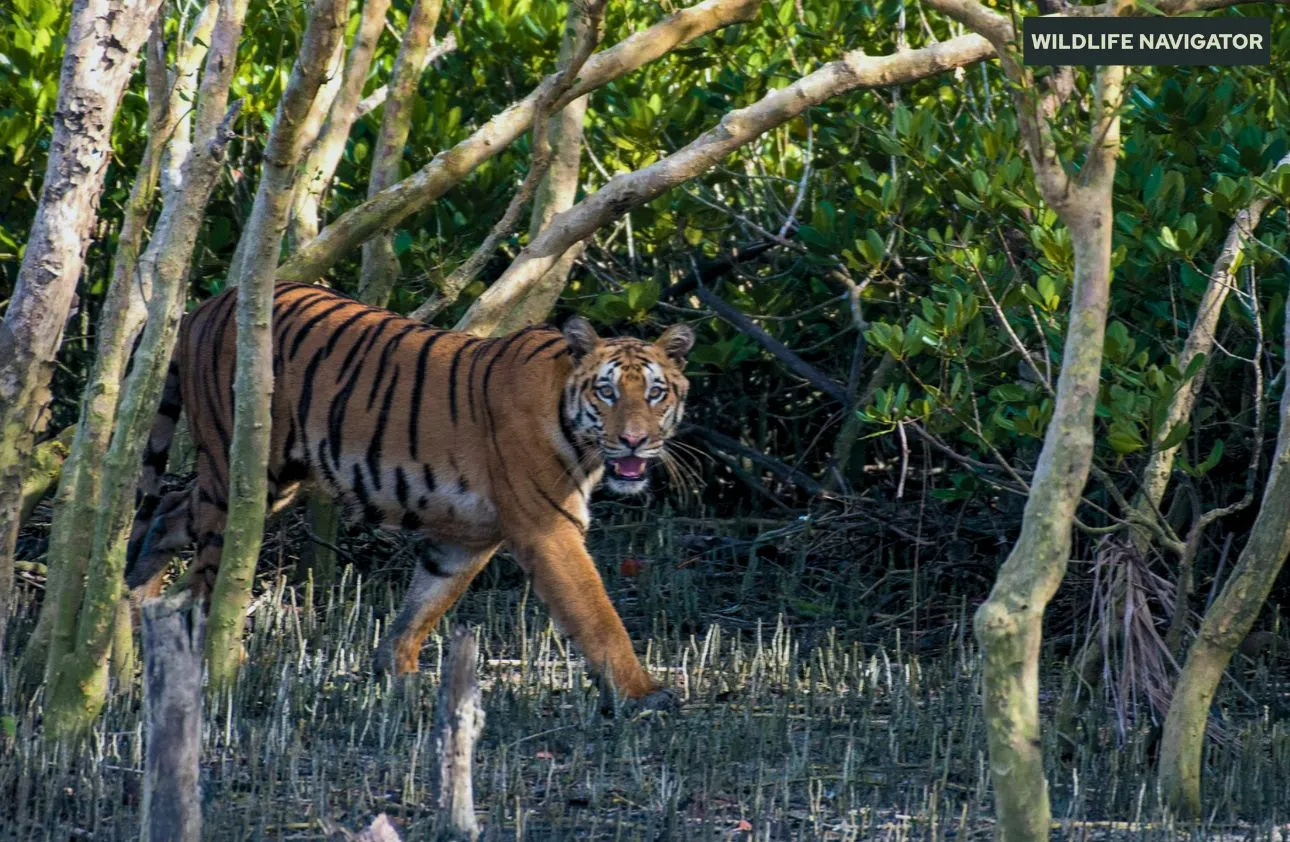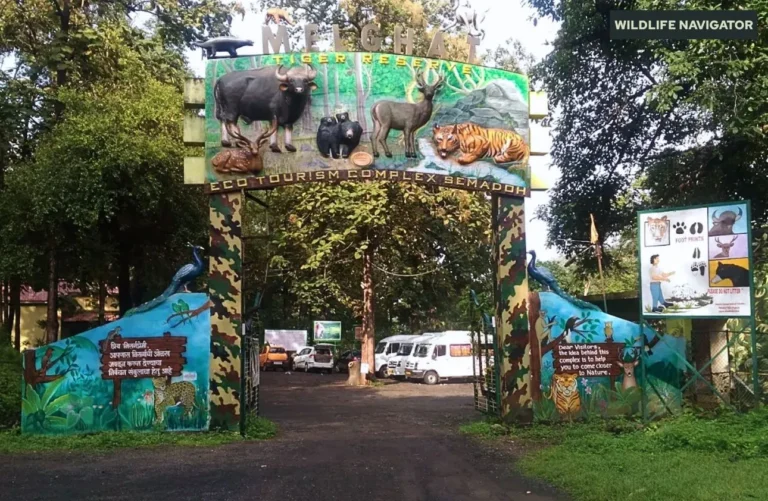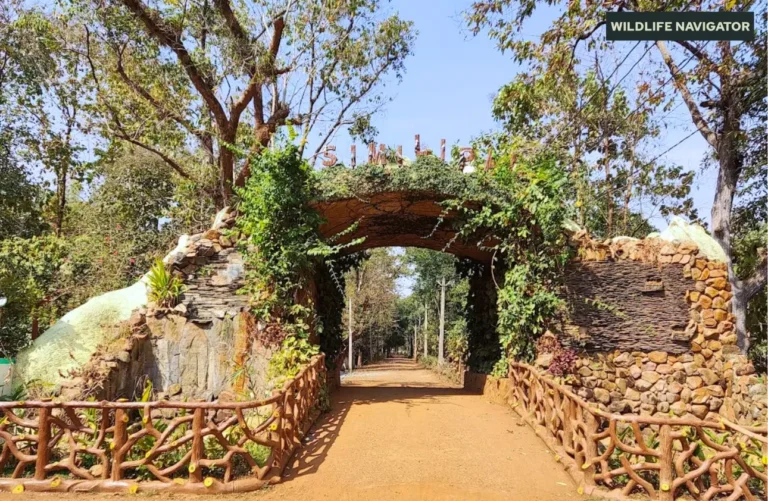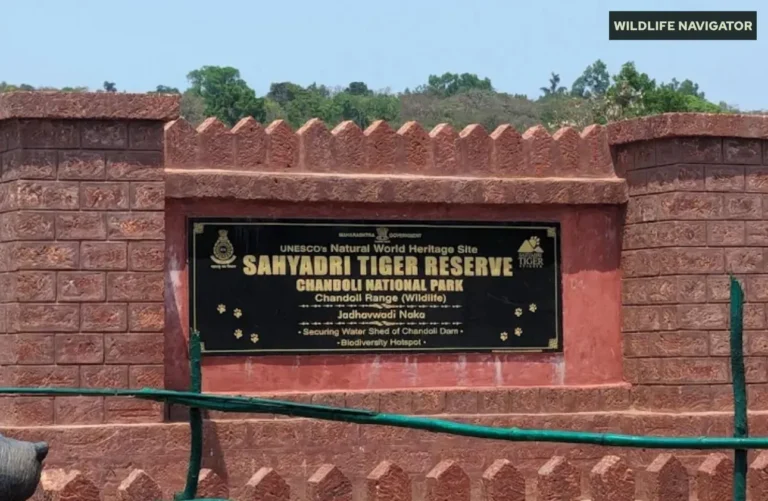Sundarbans Tiger Reserve — Protecting India’s Royal Bengal Tigers in the Mangroves

The Sundarbans Tiger Reserve, located in the southern part of West Bengal, is one of the most unique and challenging tiger habitats in the world. Unlike other reserves that span dense forests or grasslands, Sundarbans is a mangrove wilderness, where land, river, and sea blend seamlessly. Established under Project Tiger in 1973–74, this reserve plays a vital role in conserving the iconic Royal Bengal Tiger (Panthera tigris tigris) in an ecosystem shaped by tides and salinity.
Covering an area of around 2,585 sq. km, the reserve includes both core and buffer zones that encompass the Sundarbans National Park, sanctuaries, and adjoining forest areas. What sets this reserve apart is its population of tigers that have adapted to swim long distances, hunt in muddy terrain, and survive in brackish water — making them truly one of nature’s most resilient predators.
Beyond tigers, Sundarbans supports a diverse range of wildlife including estuarine crocodiles, spotted deer, fishing cats, and a dazzling array of birds. It’s not just a sanctuary for animals, but a living example of coexistence between humans and nature. For conservationists, the Sundarbans Tiger Reserve stands as a symbol of adaptation and endurance, embodying both the beauty and fragility of India’s wild heritage.
Formation and Project Tiger History
The Sundarbans Tiger Reserve has a remarkable history intertwined with India’s conservation movement. It was established in 1973–74 as one of the earliest tiger reserves under Project Tiger, a nationwide initiative launched by the Government of India to protect the rapidly declining tiger population. The reserve was created from portions of the Sundarbans forest that were already recognised for their rich biodiversity and ecological significance.
Initially, the reserve covered an area of about 2,585 sq. km, including the Sundarbans National Park as its core area and the surrounding mangrove forests as its buffer. In 1984, the core area was officially declared a National Park, strengthening protection measures and minimising human interference. Over time, this integrated network of park and reserve zones has helped safeguard not just tigers, but the entire mangrove ecosystem on which they depend.
The inclusion of Sundarbans under Project Tiger was a groundbreaking step, as it became the first mangrove habitat in the world recognised for tiger conservation. Since then, continuous efforts have been made to study tiger behaviour, track populations through camera traps, and promote community-based conservation. Despite challenges like rising sea levels and difficult terrain, the Sundarbans Tiger Reserve remains a cornerstone of India’s tiger protection strategy, symbolising hope for wildlife survival amid changing environments.
Geography and Habitat
A Unique Tidal Ecosystem
The Sundarbans Tiger Reserve lies within the vast delta formed by the Ganga, Brahmaputra, and Meghna rivers, where freshwater from the rivers meets the salty waters of the Bay of Bengal. This creates a distinctive tidal estuarine ecosystem—the largest of its kind in the world. The reserve spans approximately 2,585 sq. km, including dense mangrove forests, mudflats, creeks, and hundreds of islands interlaced with tidal waterways.
Mangrove Forests and Terrain
The Sundarbans is home to over 80 species of mangroves, including Heritiera fomes (Sundari), Avicennia alba, and Rhizophora mucronata. These salt-tolerant trees form thick canopies that protect the coastline from erosion and serve as vital breeding grounds for marine life. The terrain constantly shifts with the tides, making it one of the most dynamic and challenging landscapes for both wildlife and researchers.
A Habitat Built for Adaptation
Unlike tigers in other reserves, the Sundarbans tigers have evolved unique traits to survive here—they can swim long distances, hunt in water, and navigate muddy swamps. The fluctuating tides and salinity create a harsh yet fascinating environment that supports crocodiles, otters, spotted deer, wild boars, and migratory birds. This intricate ecosystem illustrates how life adapts and thrives even under extreme natural conditions, making Sundarbans one of the most extraordinary tiger habitats in the world.
Flora and Fauna
Flora of Sundarbans Tiger Reserve
The Sundarbans Tiger Reserve boasts one of the most complex and diverse mangrove ecosystems on Earth. With over 80 mangrove species, it represents a living barrier between land and sea, protecting coastal regions from cyclones and erosion while supporting a rich food web.
Key Plant Species
- Sundari (Heritiera fomes) – The dominant and namesake tree of the Sundarbans, known for its strong, water-resistant timber.
- Gewa (Excoecaria agallocha) – Common in saline zones; provides shade and stability to muddy banks.
- Keora (Sonneratia apetala) – Thrives in newly accreted lands; vital for land stabilisation.
- Goran (Ceriops decandra) – Forms dense undergrowth; an essential nesting site for birds.
- Avicennia marina and Rhizophora mucronata – Known for their stilt roots that allow survival in tidal conditions.
The mangrove vegetation forms natural nurseries for fish and crustaceans and filters coastal waters, playing a crucial role in maintaining ecological balance. During high tide, the forest floor submerges, creating an ever-changing landscape that supports countless forms of life.
Fauna of Sundarbans Tiger Reserve
The fauna of Sundarbans is as fascinating as its vegetation, with tigers, estuarine species, reptiles, and migratory birds all coexisting in this tidal wilderness.
Major Mammals
- Royal Bengal Tiger (Panthera tigris tigris) – The star predator; renowned for its swimming and adaptive hunting behaviour.
- Spotted Deer (Axis axis) – A key prey species and the most common ungulate in the reserve.
- Fishing Cat (Prionailurus viverrinus) – Skilled at catching fish in shallow waters.
- Wild Boar (Sus scrofa) – Found in grasslands and forest fringes.
- Small Indian Civet, Rhesus Macaque, and Indian Smooth-Coated Otter also inhabit the mangroves.
Reptiles and Amphibians
- Saltwater Crocodile (Crocodylus porosus), Water Monitor Lizard, and Olive Ridley Turtles are prominent.
- Numerous species of snakes, including King Cobra, Russell’s Viper, and Banded Krait, thrive here.
Avifauna
The reserve is a paradise for birdwatchers, hosting over 250 species of birds, including:
- Lesser Adjutant Stork
- Black-Capped Kingfisher
- White-Bellied Sea Eagle
- Open-Billed Stork
- Mangrove Whistler
- Oriental Darter
Together, this vibrant mix of flora and fauna makes the Sundarbans Tiger Reserve not only a critical conservation zone but also a living classroom of ecological harmony and adaptation.
The Royal Bengal Tiger — Behavior and Adaptations
A Predator Like No Other
The Royal Bengal Tiger of Sundarbans is unlike any other tiger population in the world. Living in a labyrinth of tidal creeks, mudflats, and mangrove forests, these tigers have developed remarkable behavioral and physical adaptations that help them survive in an environment that changes with every tide. Unlike the grassland or forest-dwelling tigers of Central and Northern India, the Sundarbans tiger has mastered the art of swimming, covering distances of up to 4–6 kilometers across estuarine channels in search of prey.
Adaptations for Survival
Over centuries, these tigers have evolved unique traits suited to the harsh saline ecosystem:
- Smaller and leaner bodies compared to inland tigers, allowing easier movement through dense mangroves.
- Partially webbed paws, helping them swim effortlessly in tidal waters.
- Salt tolerance and opportunistic diet, feeding not only on deer and boars but also on fish, crabs, and occasionally livestock near villages.
- Camouflage in mangrove shadows, their darker coat blends perfectly with the golden-green hues of the forest.
Behaviour and Territory
The Sundarbans tigers are highly territorial and solitary, with each tiger controlling large stretches of land and water. They are also known for their elusive nature—often seen as shadows moving silently through the mangroves. Because of limited prey density and tough terrain, they tend to be more aggressive and cover larger ranges than their mainland counterparts.
Despite the challenges, these tigers symbolize resilience and adaptability, embodying the true spirit of wild India. Their existence in such an unpredictable ecosystem highlights both nature’s power and fragility—a delicate balance that makes the Sundarbans Tiger Reserve a world wonder of conservation.
Biodiversity Significance and Conservation Efforts
A UNESCO World Heritage of Life
The Sundarbans Tiger Reserve holds extraordinary ecological importance. It forms the core of the larger Sundarbans Biosphere Reserve, which was designated a UNESCO World Heritage Site in 1987. This vast mangrove ecosystem acts as a natural shield against coastal erosion, storms, and cyclones, while supporting an incredible diversity of species — from microscopic plankton to the mighty Royal Bengal Tiger. It’s one of the few places on Earth where tigers, crocodiles, dolphins, and sharks share the same environment.
Conservation Challenges
However, this fragile ecosystem faces several challenges:
- Rising sea levels and climate change threaten to submerge critical tiger habitats.
- Human-wildlife conflict, especially in fringe villages, leads to tension between local communities and wildlife.
- Poaching, illegal fishing, and deforestation disrupt food chains and ecosystem balance.
- The salinity of soil and water limits regeneration of key mangrove species like Heritiera fomes (Sundari).
Protection and Management Efforts
To address these issues, the West Bengal Forest Department and National Tiger Conservation Authority (NTCA) implement multiple initiatives:
- Regular tiger population monitoring through camera traps and DNA sampling.
- Establishing eco-development committees (EDCs) to involve local communities in conservation.
- Promoting eco-tourism to generate livelihood opportunities while reducing dependence on forest resources.
- Collaboration with NGOs and research institutions for mangrove restoration and anti-poaching patrols.
Through these combined efforts, the Sundarbans continues to stand as a model of coexistence between people, tigers, and mangroves — a living example of India’s enduring commitment to wildlife protection.
Safari and Tourism Experience
A Different Kind of Safari
Unlike traditional tiger reserves where visitors explore by jeep, the Sundarbans Tiger Reserve offers a unique water-based safari experience. Here, the safari unfolds on motorized boats and launches that glide through a maze of tidal creeks and channels. These waterways reveal the reserve’s breathtaking beauty — mangrove-covered islands, sunlit mudflats, and fleeting glimpses of elusive wildlife. The thrill of spotting a Royal Bengal Tiger swimming across a creek or a saltwater crocodile basking on a muddy bank is an unforgettable highlight.
Major Safari Routes and Zones
Most safaris are conducted from Sajnekhali, the main entry point and forest office. Popular routes include:
- Sajnekhali–Sudhanyakhali–Dobanki Circuit – Known for watchtowers, mangrove canopy walks, and frequent wildlife sightings.
- Netidhopani and Burir Dabri Zones – Offer deep wilderness, historic ruins, and birdwatching opportunities.
- Bonnie Camp and Kalas Island – Remote areas ideal for those seeking quiet, untouched nature.
Each circuit is regulated by the forest department to ensure minimal disturbance to the habitat.
Best Time and Responsible Tourism
The best time to visit is November to April, when the weather is pleasant, and animal activity is at its peak. Tourists can book government-approved houseboats, launches, or day trips from Canning, Godkhali, or Gosaba.
Visitors are encouraged to practice eco-friendly tourism — avoiding plastic waste, respecting silence, and hiring licensed local guides.
Exploring Sundarbans by boat is more than a safari; it’s an immersive journey into the rhythm of the tides, where every bend reveals the untamed magic of the mangroves.
Entry Points and How to Reach
Main Gateways to the Reserve
The Sundarbans Tiger Reserve can be accessed through several key gateways in South 24 Parganas district of West Bengal. The most popular entry point is Godkhali, often called the “Gateway to Sundarbans”, from where all boat safaris begin. Other embarkation points include:
- Canning – The nearest railway station connected to Kolkata.
- Gosaba – A bustling river island that serves as a base for many eco-lodges.
- Sajnekhali – The main forest office and the official entry point for safaris.
From these points, visitors must board authorized boats or launches to explore the reserve’s waterways and forest zones.
How to Reach Sundarbans
- By Air: The nearest airport is Netaji Subhas Chandra Bose International Airport (Kolkata), about 120 km away.
- By Train: Trains from Sealdah Station (Kolkata) to Canning take around 1.5 hours. From Canning, road transport or private vehicles reach Godkhali Jetty in about an hour.
- By Road: Regular bus and car services are available from Kolkata to Canning or Godkhali.
Once at the jetty, the journey transitions into a mesmerizing boat ride through winding mangrove creeks — marking the true beginning of the Sundarbans adventure.
Accommodation and Eco-Tourism Options
Stay Amid the Mangroves
The Sundarbans Tiger Reserve offers a range of eco-friendly accommodations that blend comfort with sustainability. Since much of the reserve is accessible only by water, most stays are located on surrounding islands like Sajnekhali, Gosaba, and Bali Island. Visitors can choose from government-run forest lodges, private eco-resorts, and community-based homestays, each offering a unique window into local life and the natural world.
Popular Stay Options
- Sajnekhali Tourist Lodge (WBTDC) – Located near the Forest Interpretation Centre; ideal for first-time visitors.
- Bonnie Camp Eco Resort – Offers a more remote, wilderness experience deep inside the mangroves.
- Bali Island and Dayapur Eco Resorts – Known for sustainable practices, local cuisine, and village tours.
- Houseboats and Launch Cruises – Perfect for those wanting to spend nights drifting through the creeks.
Eco-Tourism and Community Involvement
Eco-tourism in Sundarbans isn’t just about sightseeing — it’s a community-driven initiative. Local villagers serve as guides, boatmen, and hosts, promoting responsible tourism while reducing dependence on forest resources. Many resorts also support mangrove plantation drives and wildlife awareness programs.
Staying in the Sundarbans is not merely a visit — it’s an opportunity to live within the rhythm of the tides, experience local culture, and support conservation through mindful travel.
Best Time to Visit
The best time to visit the Sundarbans Tiger Reserve is from November to April, when the weather is cool, dry, and ideal for boat safaris. During these months, tides are calmer, visibility is better, and chances of spotting tigers, crocodiles, and migratory birds increase significantly.
The winter season (December–February) offers the most comfortable temperatures, perfect for long safaris and photography. March and April mark early summer — slightly warmer but excellent for wildlife sightings as animals frequent the riverbanks.
It’s best to avoid the monsoon months (June–September), as heavy rains and cyclones can restrict safari operations and make waterways unsafe. Visiting in the right season ensures a safe, scenic, and truly magical experience of the Sundarbans’ mangrove wilderness.
Travel Tips and Safety Guidelines
Exploring the Sundarbans Tiger Reserve is an adventure like no other, but careful planning and adherence to safety guidelines are essential. Here are some key tips:
Essential Preparations
- Permits and Bookings: Obtain official forest permits in advance; book safaris and accommodations through licensed operators.
- Clothing: Wear lightweight, breathable clothes in earthy tones for comfort and camouflage.
- Gear: Binoculars, camera, insect repellent, sunscreen, and hats are must-haves for a comfortable safari.
Safety Guidelines
- Always wear a life jacket during boat rides.
- Do not disembark in restricted areas or venture into creeks alone.
- Maintain silence during wildlife spotting to avoid disturbing animals.
- Avoid feeding or approaching wildlife, including tigers and crocodiles.
Responsible Tourism
- Carry biodegradable products and avoid plastic to protect the fragile mangrove ecosystem.
- Support local guides and eco-resorts to contribute to conservation and community livelihoods.
- Follow all instructions from guides and forest officials for a safe and ethical experience.
By preparing well and following these tips, visitors can enjoy the thrill of Sundarbans safaris while protecting both themselves and the unique mangrove habitat.
Conclusion
The Sundarbans Tiger Reserve is a rare and extraordinary ecosystem, where the Royal Bengal Tiger reigns over a labyrinth of mangrove islands, tidal creeks, and rich biodiversity. Visiting the reserve is more than a safari; it’s an immersive experience in nature’s resilience, where every tide shapes the habitat and every sighting tells a story of survival.
By exploring responsibly, travellers contribute to wildlife conservation and gain a deeper appreciation of this unique wilderness — a true symbol of India’s commitment to protecting its tigers and mangroves.





